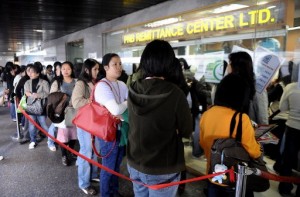Forex reserves surge to $77.77B

Filipino domestic helpers line up to send money at a remittance center in the central district of Hong Kong in this 2008 file photo. The Philippine central bank said Wednesday, March 7, 2012, that the country’s foreign exchange reserves surged further in February to post yet another record high of $77.77 billion. Given expectations that remittances would continue to increase this year and that export earnings would rebound moderately from last year’s contraction, the central bank projects that the GIR would hit at least $79 billion by the end of the year. AFP PHOTO/TED ALJIBE
The country’s foreign exchange reserves surged further in February to post yet another record high of $77.77 billion, the Bangko Sentral ng Pilipinas (BSP) reported Wednesday.
On top of the usual sources of foreign-currency inflow like remittances and foreign portfolio investments, dollar-denominated loans secured by the national government and earnings by the BSP from its investments in foreign securities helped boost the country’s gross international reserves (GIR) in February.
The latest GIR—an indicator of the country’s ability to service its debts to foreign creditors, pay imports and engage in other forms of commercial transactions with the rest of the world—was up nearly 22 percent from $63.89 billion in the same period last year.
It was also 6.5 times the country’s foreign currency-denominated debts maturing within a year and was equivalent to 11.5 months’ worth of the country’s imports.
International benchmarks say foreign-exchange reserves worth at least four months of imports are considered comfortable.
Article continues after this advertisementGiven expectation that remittances would continue to increase this year and that export earnings would rebound moderately from last year’s contraction, the central bank projected that the GIR would hit at least $79 billion by the end of the year.
Article continues after this advertisementBSP Governor Amando Tetangco Jr. earlier said the rising foreign-exchange reserves indicated the country’s improving ability to service its maturing obligations with foreign creditors and thus make the country worthy of better credit ratings.
The Philippines, after getting favorable credit-rating actions last year, is hoping for another round of upgrades from various international rating agencies to finally hit investment grade.
The country’s credit ratings with Moody’s Investors Service and Standard & Poor’s both stand at two notches below investment grade, while that with Fitch Ratings stands at a notch below.
Finance Secretary Cesar Purisima said the government’s improving fiscal standing, evidenced by rising revenue collection and declining proportion of its debt to the gross domestic product, was another reason why the country deserved better credit ratings.
The Philippines is hoping to get investment grade by 2013.
Standard & Poor’s on Wednesday reiterated the likelihood of the Philippines getting a credit-rating upgrade this year, citing the improving fiscal position of the government and the country’s growing economy.